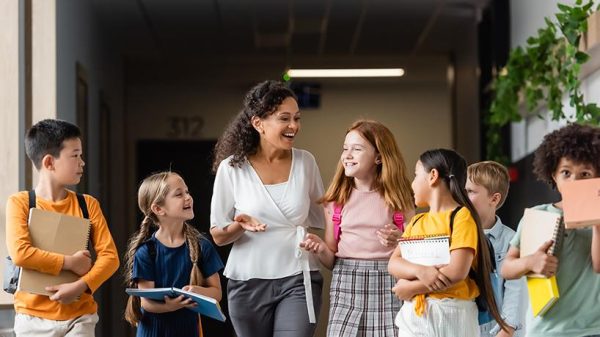Nature offers a unique perspective on learning. Taking time to observe nature’s finned and feathered friends can spark creative thinking and elevate our professional practice. The world of nature is outside our doors to teach us.
Educators often learn through spoken and written words. Animals learn by observation and action. What if educators learned more like the animals? Here are three examples of wildlife learning in their natural environments that offer lessons for us.
Osprey Flying Lessons
Learning to fly is the first important step for young ospreys. An osprey is a large bird of prey resembling an eagle. Each spring, an osprey couple nests on our boathouse, the site of the flying lessons.
Osprey chicks fly instinctively. However, parents nurture them to fly by using a variety of strategies. Osprey parents model nest takeoffs and landings. To lighten the birds and prepare them for flight, osprey parents may withhold food just before fledging time. Sometimes parents will use food to tempt the juveniles to make the first scary leap. In the nest, they model wing flapping to encourage the chicks to exercise their wing muscles.
The chicks practice by making short hop flights across the nest. Sometimes the fledglings make brief hover flights above the nest, letting the wind catch their wings and suspend them in the air for seconds at a time. With the example set by its parents and confidence in the power of its wings, the young osprey eventually takes flight away from the nest.
When the fledgling’s attempts to land on a tree branch are awkward and uncertain, a parent flies to its side, modeling and coaching. This is the way young ospreys receive feedback. With practice, the young osprey’s first awkward flaps turn to sailing and soaring. Learning to fly is the first important step for young ospreys.
The second step is mastering sophisticated fishing skills. Until ospreys learn to fish successfully, the juveniles must rely on their parents for food. Ornithologists have noted that while the juveniles are flying around and learning to fish, sometimes they will land on a neighboring osprey nest. Other adult ospreys are welcoming of wayward juveniles and may even feed the visiting fledglings before they return to their home nests. Although an osprey family lives in single nest, the families are part of a larger community.
Osprey flight school relies on expert demonstration, modeling, coaching, persistence, and, occasionally, some support from the osprey community. There is no ground school for young ospreys, only flight school.
Ospreys don’t collide during flying lessons. Why? And how do they communicate? Effective communication is sometimes silent. Gestures, body language, and quiet mindfulness of others can be more powerful than words. A bird’s hearing surpasses humans and is attuned to its surroundings.
Trying a new strategy or idea with students can be scary, just like the osprey flying for the first time, and requires courage. And learning requires doing.
Dolphin School
While boating in a shallow bay, we encountered a dolphin school with about 10 mature dolphins and the same number of small dolphin calves. Dolphins are socially skilled, intelligent, agile, and playful animals.
Dolphins seem to have learning figured out. Dolphin calves are not born with the skills to care for themselves. Dolphin mothers are their teachers. Important lessons include learning how to breathe, swim, hunt food, and jump — all while having fun.
We observed each dolphin mother repeatedly model the jumping behavior by arcing through the air, circling below the water, then lifting the baby with her nose until the dolphin jumped on its own.
Why do dolphins jump? Scientists think it may be for the view, to communicate with other members in the pod, or perhaps just to play and have fun. The dolphin calves learn to swim by shadowing their mothers’ movements.
Dolphins also teach their young to communicate clearly. They use clicks to sense their surroundings and whistles to communicate with other members of their species.
Dolphins are incredibly curious. When the dolphins noticed us, they swam to the boat, happily letting us touch them. Young dolphins also have the support of community during the learning process. Pod members are willing to lend a fin or flipper when needed.
Dolphin school includes expert demonstration, modeling, and shadowing, with time for curiosity and play. The learning is appropriate for the young dolphin’s level of mastery –neither too difficult nor too easy. Imagine how human learning could be accelerated with more curiosity and play. For dolphins, learning is fun and has frequent celebrations.
Tarpon Tale
This tarpon tale is one of perseverance, endurance, and community. The tarpon is nicknamed “silver king” due to its majestic appearance, size, and color. These fish can measure up to 8 feet, weigh up to 280 pounds, and live more than 50 years. Tarpon also have a unique ability to gulp air at the surface when they are in a habitat that doesn’t provide enough oxygen.
Because of its strength, stamina, and fighting ability, the tarpon is one of Florida’s premier game fish. During a fishing tournament, we observed a boater battle to bring in a large tarpon. The fish waged a valiant fight for almost 30 minutes — then the line snapped. As the lifeless tarpon floated close to our boat, we watched in amazement as a large group of tarpon circled the motionless fish and began to churn the water. Their actions provided oxygen the tarpon needed to breathe. Within a few minutes, the revived tarpon swam off with the entire community.
When one of their fellow fish needed support, the tarpons adapted and immediately responded. They didn’t overanalyze how to save the fish. Instead, the fish community helped instinctively. What lessons about community does the tarpon tale tell? The tarpons worked together to preserve their community.
In many ways, these three wildlife scenarios parallel how humans learn. Research by Malcolm Knowles (1984) explains that learning must be purposeful, problem-driven, and allow for knowledge and experience to be valued and applied.
For human learners, choice and interest are also learning motivators. In his book, Drive, Daniel Pink (2011) cites the importance of “Goldilocks” tasks — learning that is neither too difficult nor too easy. Animals seem to instinctively understand this Goldilocks effect.
The osprey, dolphin, and tarpon also demonstrated of the power of collaboration. John Hattie’s (2015) concept of “collective efficacy” illustrates how learning improves when educators work together to make each other better.
What would these lessons from nature look like if integrated in your learning?
- Observe.
- Model.
- Practice.
- Coach.
- Communicate.
- Listen.
- Learn.
- Grow.
- Encourage.
- Play.
- Persist.
- Persevere.
- Soar.
- Celebrate.
- Be curious.
- Be strong.
- Be courageous.
- Be adaptable.
- Be mindful.
- Find your oxygen.
- Trust your instincts.
- Connect with community.
- Stick together.
- Practice “Goldilocks” learning.
- And, when possible, flap your wings (or fins) and jump for joy.
References
Hattie, J. (2015). What works best in education: The politics of collaborative expertise. London, England: Pearson.
Knowles, M. (1984). Andragogy in action. San Francisco, CA: Jossey-Bass.
Pink, D. (2011). Drive: The surprising truth about what motivates us. New York, NY: Penguin.







